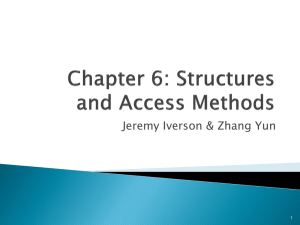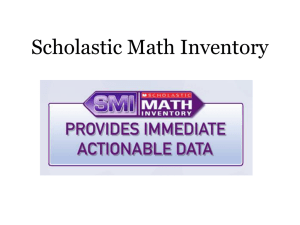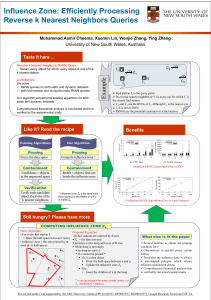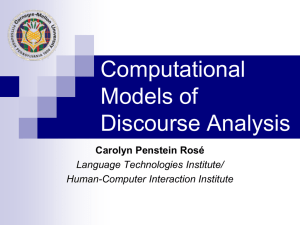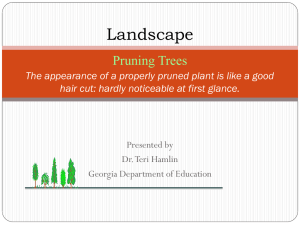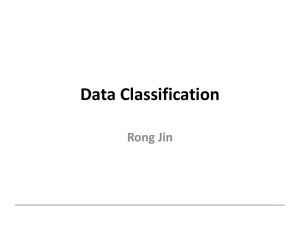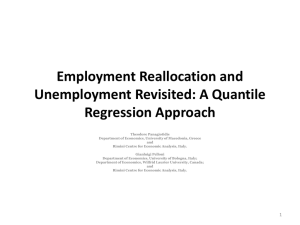Quantile-Based KNN over Multi-Valued Objects
advertisement
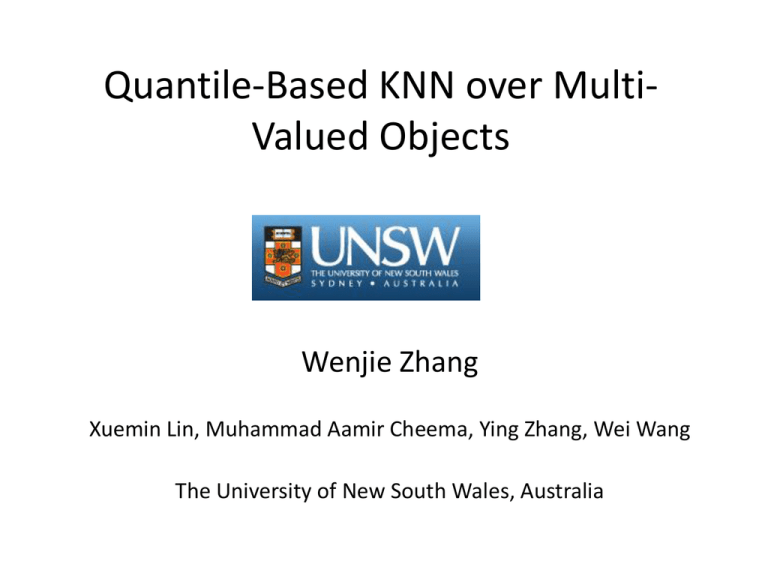
Quantile-Based KNN over MultiValued Objects Wenjie Zhang Xuemin Lin, Muhammad Aamir Cheema, Ying Zhang, Wei Wang The University of New South Wales, Australia KNN Query • Find k objects closest to query q o4 o1 q o2 o3 2-NN of q: o2 and o4 2 KNN Query • Find k objects closest to query q • What if objects have multiple values ? Player A Player B q 3 Existing Models for Multi-instances • Probabilistic KNN Models – Probability is computed by summing up probabilities of all valid possible worlds – Probable top-k NN: [Bekales, Soliman, Ilyas. VLDB 08] Probabilistic verifiers: [Cheng, Chen, Mokebel, Chow. ICDE 08] 4 Probabilistic KNN Model q and have the same probability to be NN of q 5 Probabilistic KNN Model q and have the same probability to be NN of q 6 Probabilistic KNN Model q and have the same probability to be NN of q 7 Probabilistic KNN Model • ties • Not very sensitive to relative distribution of objects instances • Different semantics than multi-value objects ! 8 Aggregate Distances • Existing: mean, minimal, maximal, etc • Generalization: quantile distance 9 Applications • • • • GIS Location based service Radio Frequency Identify Device … 10 Contributions • Distance between two multi-value objects – Quantile distance – Quantile group-base distance • KNN processing – Linear time algorithm for quantile distance – Pruning Techniques on object & instance level 11 Preliminaries • Φ-quantile: – The first element in a sorted list with the cumulative weight not smaller than Φ, where Φ is a number in (0, 1]. Sorted elements: Weights: 3 6 7 8 .10 .15 .20 .15 8 10 .10 .05 13 .10. 15 .15 Cumulative weight: 0.45 0.5-quantile 0.8-quantile 12 Preliminaries • Multi-valued Object: – A set of weighted instances in d-dimensional space – The sum of the weights equals to 1 13 Quantile Distances • Φ-quantile distance ¼ ½ ½ ¼ Instance pairs: Weights: ½ (q2, u1) (q3, u1) (q3, u2) (q1, u1) (q2, u2) (q1, u2) 1/8 1/8 1/8 1/4 1/8 1/4 0.25-quantile 0.5-quantile 14 Quantile Distances • Φ-quantile group-base distance – Candidate group: a subset S’ of elements set Q x U such that the total weights of elements in is not smaller than Φ. – The minimal total weighted distance among all candidate groups, namely with the minimal 15 Quantile Distances • Φ-quantile group-base distance Φ = 0.5 Instance pairs: Weights: (q2, u1) (q3, u1) (q3, u2) (q1, u1) (q2, u2) (q1, u2) 1/8 1/8 1/8 1/4 1/8 1/4 16 Problem Definition Given a set of multi-valued objects, a multivalued query object and Φ in (0, 1], retrieve K objects with smallest Φ-quantile distance and Φ-quantile group-base distance to the query object. 17 Framework • Seeding – Select k objects and compute quantile distance --- k seeds are selected based on mean – Challenge: efficient computation of quantile distances • Refinement: – Determine the final solution – Challenge: efficient pruning techniques 18 Φ-quantile Distance • Multi-value objects U and V – Overall m=|U| * |V| instance pairs – Existing: Disk-based Quantile computation: O(mlogm) with pruning --- Yiu et al EDBT 06 – Our contribution: O(m) algorithm with pruning Basic Idea: index instances by R-tree; prune entry pairs at higher levels using bounding techniques 19 Φ-quantile Distance U2 0.5 0.5 U1 Φ=0.6 V1 0.4 lower bound (U1, V1) 0.2 (U1, V2) 0.3 (U2, V1) 0.2 0.6 V2 Φ=0.6 – 0.2 (U2, V2) 0.3 upper bound 20 Φ-quantile KNN • λk: the largest distance of the K seeded objects • Global R-tree: indexes the MBB of the multi-value objects set • Local R-tree: indexes the instances of multi-value objects (query, object set) 21 Φ-quantile KNN • Distance based pruning rule on Global R-tree E from global R-tree ≥λk Q 22 Φ-quantile KNN • Weight based pruning rule on Global R-tree Entry E: Let Ω denote the set of entries with minimal distance ≤ λk, if the total weight of entries in Ω is ≤ Φ, then every object in E could be pruned. E from global R-tree Q Q2 Q1 minimal distance: mindist(Q2, E) ≤ λk weight(Q2) ≤Φ 23 Φ-quantile KNN • Pruning on the Local R-tree of Q and U – Trim the local R-tree of both Q and U by λk level by level. Discard entries in Q with minimal distance to U larger than λk, similarly for U. – Denote the total weight of remaining entries as PQ and PU, respectively, if PQ * PU ≤ Φ, then U can be pruned. 24 Φ-quantile KNN • Pruning on the Local R-tree of Q and U U U2 U1 Q Q2 Q1 minimal distance: mindist(Q1, U) ≥ λk minimal distance: mindist(Q, U2) ≥ λk weight(Q2) * weight(U1) ≤Φ 25 Φ-quantile KNN • Overall processing – 1. Pruning on Global R-tree based on distance – 2. Pruning on Global R-tree based on weights – 3. Pruning on Local R-tree – Φ-quantile distance computation 26 Φ-quantile Group-base Distance • From |Q| * |U| instance pairs, select a set of pairs such that – the sum of weights is ≥ Φ – the weighted distance is minimized • Reduced to Knapsack problem. NP-hard 27 Φ-quantile Group-base Distance • Approximate algorithm with ratio 2 and time complexity O(m log m), where m is the total number of instance pairs. sorted distance: weight: 1 0.28 2 0.12 3 0.48 4 0.12 possible solution: 1.72 (1, 0.28), (3, 0.48) possible solution: 1 (1, 0.28), (2, 0.12), (4, 0.12) 28 Φ-quantile Group-base KNN • Prune a set of objects on Global R-tree based on distance E L Q Φ * L ≥ λk 29 Φ-quantile Group-base KNN • Prune a set of objects on Global R-tree based on weights – Traverse the local R-tree of Q – Sort entry pairs according to lower bound distance at each level of Q 30 Q E Q3 Q1 Q2 Q4 Φ = 0.5 (1, 0.28) Global R-tree 0.5-quantile (2, 0.12) d1= 1 * 0.28 + 2 * 0.12 (3, 0.48) (4, 0.12) d2= 3 * (Φ – 0.28 – 0.12) If d1 + d2 ≥ λk, then E could be removed. 31 Φ-quantile Group-base KNN • Overall Processing – 1. Distance based pruning on Global R-tree – 2. Weight based pruning on Global R-tree – Φ-quantile Group-base distance calculation 32 Experiment • Real Dataset – NBA player statistics – 339, 721 records of 1,313 players – 3 dimension • Synthetic Dataset – – – – Size: 10, 000 to 50, 000 Instances: 400 to 2, 000 Dimension: 2 to 5 MBB length, spatial distribution, instance distribution, weight distribution … 33 Φ-quantile Distance Computation 34 Overall Performance • Naive algorithms refer to techniques without pruning rules 35 Pruning Powers 36 Accuracy 37 Varying Parameters 38 Conclusions • Distance between two multi-value objects based on quantile • A linear algorithm for quantile distance computation with pruning • Efficient KNN processing techniques 39 Thanks 40
